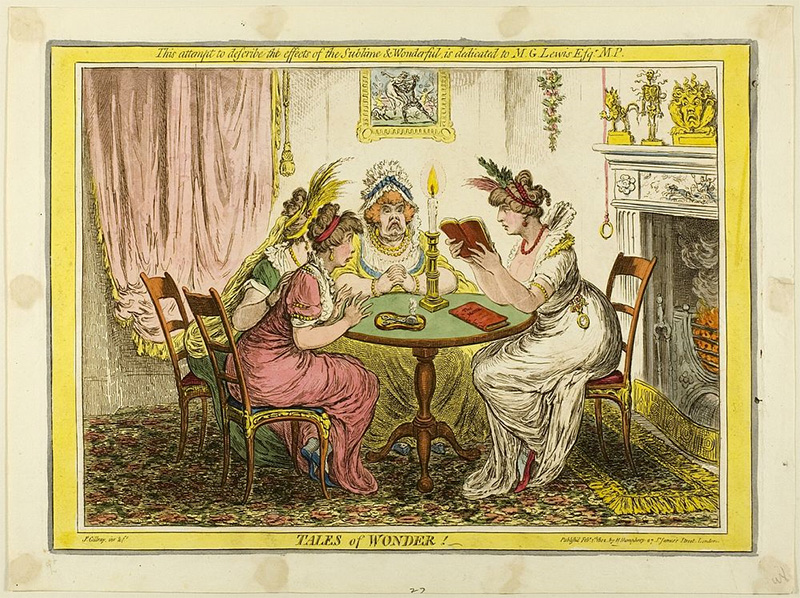
Hanging upon my wall is an etching by the British artist / satirist James Gilroy (1756–1815) titled Tales of Wonder.
To my eyes, it’s a wonderful work of art, brilliantly animated with life. In the style of the time, it contains a wealth of information — almost a narrative.
The first version of this print was published in London, in 1802. As was the practice of the day there were multiple printings of such etchings, with some variations in the imagery. It takes a print specialist to give a specific date for such popular printings based on these variations, so I have no idea what my iteration might be. Surely, however, it was made somewhere about 1802–1803. Since in those days there was no color printing, it was hand-colored.
Gilroy, who has been called the “Father of the political cartoon,” is here showing four well-dressed women of the moment, in a room that depicts considerable wealth.
Three of the women are being read a highly popular (and sensational) 1796 novel titled The Monk by the English writer, Matthew Gregory Lewis, which he wrote before he was twenty. In its day, the book was both highly scandalous and enormously successful, so successful that Lewis came to be called “Monk” Lewis.
A Wikipedia summary of the novel tells us that it is a story about a virtuous monk who gives into his lustful urges, setting off a chain of events that leaves him damned. “It is a prime example of the type of Gothic novel that specializes in horror.” In fact, it has been suggested that it was Lewis who paid Gilroy to create this illustration as an advertisement for the book. The print also became very popular.
[You can read the book online.]
The Monk was widely imitated and copied, setting a fashion for such novels. Indeed, in our own time, the most widely read forms of the novel are the romance and the thriller. A connection? I’m willing to think so.
The image — as was the fashion of the day — gives a variety of clues as to what is happening. The women are transfixed by the story, showing both fascination and horror.
I do wonder about these women. They are all wealthy and could have owned their own copies of the book. Does that mean the reader is the only one who is literate? No clues.
A watch that hangs from the reader’s waist shows the time to be 12:45 PM, telling us that the women are so enthralled by the book that they are staying up past midnight.
To suggest the full gothic elements of the book, there is the figure of a skeleton adorned by snakes sitting on the mantel. There is also a sculpture of a dragon. On the wall, an image of a knight abducting a young woman.
The original book was published in three volumes, but the print shows only two. No suggestion as to why.
I found my print years ago in a thrift store in St. Paul (Minnesota). I was there because I was giving a talk. I had been wandering about, and spied it midst the shop’s clutter, recognized it for what it was, and bought it for what I am sure was far less than its true value.
How did it get there? Who knows?
Why is it on my wall? Beyond all else — for me — the image depicts the joy — and thrill — of reading.